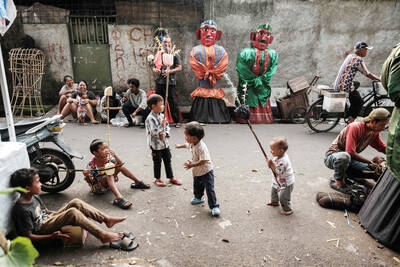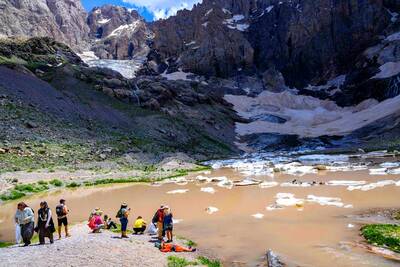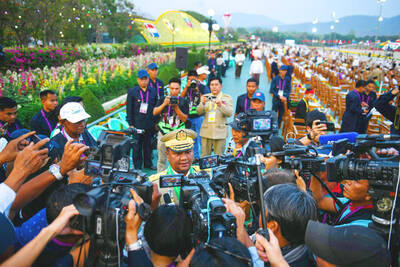Nepalese soldiers and police guarding the slopes of Mount Everest are authorized to shoot to stop any protests during China’s Olympic torch run to the summit, an official said yesterday.
Chinese climbers plan to take the torch to the summit of Everest in the first few days of next month. During that time, other climbers will be banned from the mountain’s higher elevations.
Police and soldiers “have been given orders to stop any protest on the mountain using whatever means necessary, including use of weapons,” Nepal’s Home Ministry spokesman Modraj Dotel said, adding that the use of deadly force was authorized only as a last resort.
The troops will first attempt to persuade protesters to leave and will arrest those who don’t.
If demonstrators defy all nonviolent means of restraint, troops have the option of using their weapons. It was unclear if the protesters would have to attack or become violent before force was authorized.
Twenty-five soldiers and policemen have already established several camps on the mountain, Dotel said.
The torch relay was meant to highlight China’s rising economic and political power, but activists have seized on it to protest China’s human rights record.
It has drawn particular ire from those denouncing China’s rule in Tibet following a crackdown on demonstrations in the Himalayan region last month.
Tibetan exiles have protested almost daily in the Nepalese capital of Kathmandu.
The UN and international rights groups have criticized Nepal for using what they say is excessive force to stop the demonstrations.
Dotel said Nepal cannot allow any protests against China.
There are already dozens of mountaineers on Everest for the popular spring climbing season. Climbers spend weeks acclimatizing and making practice runs up the slopes before attempting the 8,850m summit.
They will be barred from going above Camp 2 at 6,600m until the Chinese finish their torch run. The harsh weather on Everest allows only about two windows — anywhere from a couple of days to a week — in May when conditions are favorable enough for the push to the summit.
The Olympic flame arrived in Malaysia yesterday ahead of a relay in which it will be guarded by about 1,000 police watching for possible protesters.
The flame, stored in a special container, arrived from Bangkok at about 2am on a plane dedicated to carry it to all 19 international destinations on the torch relay before it lands in Beijing for the Olympic Games’ opening ceremony in August.
The flame was taken to a luxury hotel in downtown Kuala Lumpur ahead of today’s relay run starting at nearby Independence Square.
Policemen and commandos will be deployed along the route even though police have not received reports of any planned protests, said a police spokesman, who declined to be named citing protocol.
Roads will be closed to traffic along the route.
Police “are fully aware of the challenges that this torch has faced in other situations, and they have been organizing themselves to face any of these challenges,” said M. Jegathesan, vice president of the Olympic Council Malaysia.
In related news, an ancient Japanese Buddhist temple, which canceled its role in the protest-marred Olympic torch relay, has been vandalized with white spray paint, police said yesterday.
The Zenkoji Temple in Nagano on Friday withdrew from plans to be the start point for the Japanese leg of the relay on April 26 because of China’s crackdown in Tibet.
Six white spray paint graffiti patterns were found on pillars and sliding doors at the main sanctuary of the 1,400-year-old temple early yesterday, a spokesman for the Nagano Prefectural police said.
“We have yet to ascertain if the act was related to the torch relay. It could possibly be a malicious practical joke,” he said.
The graffiti patterns, as large as 60cm by 80cm, did not contain written messages, the police spokesman added.
“The graffiti, including simple circles, are similar to what are drawn on street guard rails. They may not be directly aimed at the relay,” a spokesman for the temple told reporters.

In the sweltering streets of Jakarta, buskers carry towering, hollow puppets and pass around a bucket for donations. Now, they fear becoming outlaws. City authorities said they would crack down on use of the sacred ondel-ondel puppets, which can stand as tall as a truck, and they are drafting legislation to remove what they view as a street nuisance. Performances featuring the puppets — originally used by Jakarta’s Betawi people to ward off evil spirits — would be allowed only at set events. The ban could leave many ondel-ondel buskers in Jakarta jobless. “I am confused and anxious. I fear getting raided or even

Kemal Ozdemir looked up at the bare peaks of Mount Cilo in Turkey’s Kurdish majority southeast. “There were glaciers 10 years ago,” he recalled under a cloudless sky. A mountain guide for 15 years, Ozdemir then turned toward the torrent carrying dozens of blocks of ice below a slope covered with grass and rocks — a sign of glacier loss being exacerbated by global warming. “You can see that there are quite a few pieces of glacier in the water right now ... the reason why the waterfalls flow lushly actually shows us how fast the ice is melting,” he said.

RISING RACISM: A Japanese group called on China to assure safety in the country, while the Chinese embassy in Tokyo urged action against a ‘surge in xenophobia’ A Japanese woman living in China was attacked and injured by a man in a subway station in Suzhou, China, Japanese media said, hours after two Chinese men were seriously injured in violence in Tokyo. The attacks on Thursday raised concern about xenophobic sentiment in China and Japan that have been blamed for assaults in both countries. It was the third attack involving Japanese living in China since last year. In the two previous cases in China, Chinese authorities have insisted they were isolated incidents. Japanese broadcaster NHK did not identify the woman injured in Suzhou by name, but, citing the Japanese

RESTRUCTURE: Myanmar’s military has ended emergency rule and announced plans for elections in December, but critics said the move aims to entrench junta control Myanmar’s military government announced on Thursday that it was ending the state of emergency declared after it seized power in 2021 and would restructure administrative bodies to prepare for the new election at the end of the year. However, the polls planned for an unspecified date in December face serious obstacles, including a civil war raging over most of the country and pledges by opponents of the military rule to derail the election because they believe it can be neither free nor fair. Under the restructuring, Myanmar’s junta chief Min Aung Hlaing is giving up two posts, but would stay at the